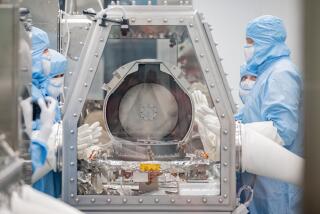After repairs, Hubble telescope let loose in space
- Share via
CAPE CANAVERAL, FLA. — A rejuvenated Hubble Space Telescope, more powerful than ever, departed the space shuttle Tuesday and sailed off for new discoveries.
“It’s showtime for us now,” program scientist Eric Smith said.
Hubble -- considered to be at its prime after five days of repairs and upgrades -- was gently dropped overboard by the shuttle Atlantis astronauts, the last humans to see the 19-year-old observatory up close.
It was NASA’s last service call and, despite spacewalking moments ranging from anguish to elation, it turned out to be “a 110% successful mission,” senior project scientist David Leckrone said.
“Today begins the second Hubble revolution,” an emotional Leckrone said from Houston.
Smith ticked off a few of Hubble’s early accomplishments: determining the age of the universe, finding dark matter, studying planets around other stars. “Now it’s even better,” he said. “I am really looking forward to what comes next.”
The shuttle and telescope had just crossed the Atlantic, and were soaring 350 miles above the coast of northwestern Africa, when robot arm operator Megan McArthur set Hubble free. Then the shuttle slowly backed away.
With Hubble flying on its own again, the seven astronauts looked ahead to Friday’s planned landing. But first they had to inspect their ship one last time to make sure it had not suffered any serious damage from space junk. The wing and nose survey, similar to one performed last week to check for launch damage, consumed their afternoon.
The telescope’s unusually high orbit had placed the shuttle and its crew at increased risk and, because of the lack of a refuge, prompted NASA to keep a rescue ship on standby until the end of the 11-day mission. To improve their safety, the astronauts dropped Atlantis into an egg-shaped orbit that is, much of the time, lower than the telescope’s junk-ridden orbit.
During five consecutive days of spacewalks loaded with drama, Atlantis’ crew labored tirelessly on the observatory. Four crew members working in teams of two gave the telescope two new high-powered science instruments and a suite of other up-to-date equipment, and fixed two broken instruments, something never before attempted in orbit.
The Hubble team hopes to resume celestial observations by the end of summer.
At the end of this month, the improved Hubble will take its first pictures, but only to make sure its instruments are working.
The image will be a well-studied cluster of stars in the constellation Sagittarius that go by the boring name NGC6681. Astronomers have known about this group of stars for nearly 230 years. It is about 29,000 light years away.
Astronomers expect to get another five to 10 years of use out of the telescope, thanks to the astronauts’ effort.
As for Hubble’s future after that, there will be no more visits. Sometime after 2020, NASA will send a robotic craft to steer it back into the atmosphere and to a watery grave. The spacewalkers installed a docking ring for just that purpose.
More to Read
Sign up for Essential California
The most important California stories and recommendations in your inbox every morning.
You may occasionally receive promotional content from the Los Angeles Times.













